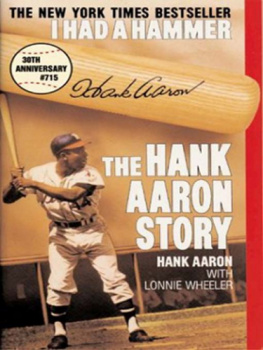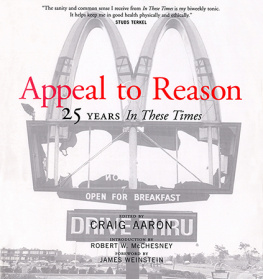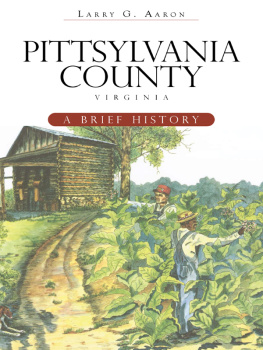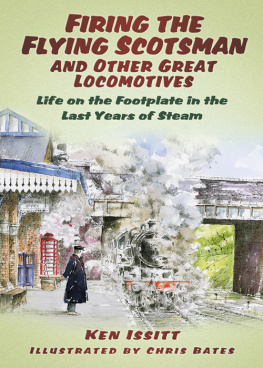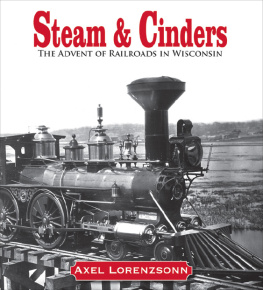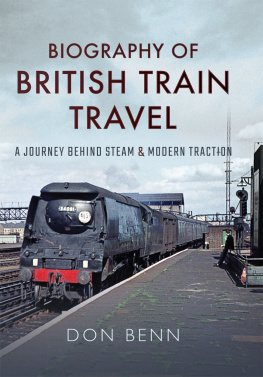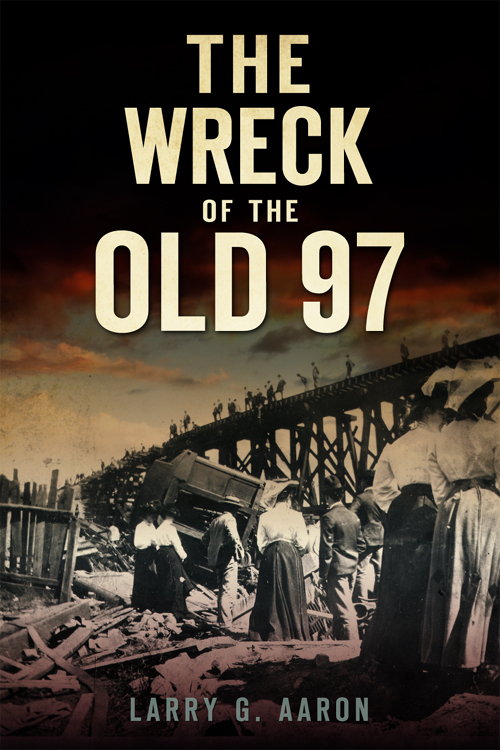THE
WRECK
OF THE
OLD 97
THE
WRECK
OF THE
OLD 97
LARRY G. AARON

Published by The History Press
Charleston, SC 29403
www.historypress.net
Copyright 2010 by Larry G. Aaron
All rights reserved
Back cover illustration courtesy of Grays Watercolors of New Jersey.
First published 2010
Second printing 2010
Third printing 2011
e-book edition 2011
ISBN 978.1.61423.057.1
Library of Congress Cataloging-in-Publication Data
Aaron, Larry G.
The wreck of the Old 97 / Larry G. Aaron.
p. cm.
Includes bibliographical references.
print edition: ISBN 978-1-59629-876-7
1. Railroad accidents--Virginia. I. Title.
HE1780.5.V8A17 2010
363.12209755666--dc22
2010024367
Notice: The information in this book is true and complete to the best of our knowledge. It is offered without guarantee on the part of the author or The History Press. The author and The History Press disclaim all liability in connection with the use of this book.
All rights reserved. No part of this book may be reproduced or transmitted in any form whatsoever without prior written permission from the publisher except in the case of brief quotations embodied in critical articles and reviews.
To the memory of my late uncle J. Ryland Groff, locomotive engineer,
Seaboard Air Line Railway.
CONTENTS
FOREWORD
The wreck of the Old 97 on the Southern Railway near North Danville, Virginia, on Sunday, September 27, 1903, is one of the most famous railroad wrecks in American history. From the moment of the crash until today, numerous legends surrounding this terrible event have been told and retold until it is difficult to separate fact from fiction.
Over the years, an amazing number of people have been connected to the wreck in some waytheir ancestors witnessed it or arrived at the scene afterward, they were involved in the legal controversy concerning authorship of the ballad or they claim possession of an artifact from the wreckage. In other instances, they believed their ancestor was supposed to have been on the train that day but missed it for some reason.
Since researching and writing my booklet, History of the Wreck of the Old 97, nearly three decades ago, additional information regarding that tragic train wreck has been discovered. Dr. Larry Aaron of Danville, who shares my interest in local and railroad history, has meticulously and masterfully researched the court records of civil trials resulting from the tragedy, located and interviewed descendants of the crew and witnesses, gathered opinions from various rail experts and made logical conclusions about possible causes of the wreck.
His theory regarding the reason for the excessive speed of Old 97 as it approached Stillhouse Trestle is certainly logical. Dr. Aarons colorful and knowledgeable commentary in this book gives the reader great insight into railroad operations in 1903 and into the role that railroads and their dedicated employees played in building this great nation.
Both historians and rail fans will gain greater understanding of the circumstances surrounding this tragedy, which occurred over one hundred years ago but continues to live on in American folklore. Dr. Aaron is to be heartily commended for his diligent research and thorough documentation of his findings.
G. Howard Gregory
Captain, Virginia State Police (Retired)
ACKNOWLEDGEMENTS
This book could not have been written without the help of a number of individuals who critiqued the manuscript, contributed photos and information, granted interviews and in other ways assisted with its publication. Because of the contributions of those below, this book contains new unpublished information related to the wreck and new photographs.
First and foremost, Howard Gregory, a retired Virginia State Police captain, published a popular history of the wreck of the Old 97 that is no longer in print. He graciously gave me permission to use his resources and also acted as consultant throughout this project.
Other authors of histories of the wreck, some just a few pages and others larger booklets, that I consulted must be acknowledged: Pat Fox, James I. Robertson, Raymond B. Carneal, Lloyd Clemmer and William Webb. Each of these writers made contributions to the story that set him apart from the others.
I could not have done without the voluminous files of information and photos of the wreck collected by Danville historian and author Clara Fountain. A retired school librarian, she authored the first childrens book on the tragedy, The Wreck of the Old 97, which is still available.
Danville historian and friend Danny Ricketts generously shared his information about the wreck, as well as assisting me in mapping Old 97s route through Danville. He and his wife, Nancye, also published the first coloring book related to the wreck for the Old 97 Centennial celebration in 2003.
Another whose friendship I have enjoyed over the years, Lawrence McFall, provided his resources and took me to all of the local sites in Danville where one can still see the remains of the old mainline where 97 ran.
This past summer, my wife and I hitched a ride on the Western Maryland Scenic Railroad, which took us from Cumberland to Frostburg. Not only was it my first steam locomotive ride, but I also stood in the cab of a 1916 Baldwin engine, which was similar to Broadys 1903 Baldwin engine No.1102. Special thanks to the Western Maryland management and especially to Dan Pluta, engineer and chief mechanical officer, whose photo appears in this volume.
That same weekend, I also enjoyed a ride on the Potomac Eagle, a wonderful excursion train at Wappocomo Station in Romney, West Virginia. The train was pulled by a diesel locomotive run by engineer Rodney Matheny, who also contributed to my knowledge about trains for this book.
My research was also greatly enhanced by the archives and assistance of railroad historians from the Norfolk and Western Historical Society. Thanks to Bob Cohen for his copies of train schedules and other printed materials and his general knowledge of railroad history; to Dave Stephenson, retired from the Surface Transportation Board, for his engineering calculations comparing Broadys engine with others of that day; and to Louis Newton, author and retired official of Norfolk and Western and Norfolk Southern Railways, who offered his insight into the cause of Old 97s wreck.
In addition, author and railroad historian Ed Conner, through his books and correspondence, provided information about Southerns Washington Division. Both Dr. Gene Lewis of the Greensboro chapter of the National Railway Historical Society and Dr. Frank Scheer, adjunct professor at the University of Maryland and curator of the Railway Mail Service Library, provided assistance and resources.
Other railroad men were a big help as well. They include Bob Miller of Hayes, Virginia, retired conductor for the Chesapeake and Ohio Railway; and Terry Feichtenbiner, retired engineer for the C&O, who has had extensive experience with steam locomotives. Both men gave me a great deal of insight into what might have happened in those last few moments before Old 97 jumped the trestle.
Special thanks go to a number of others who helped with specific requests: Jason Moore and Bridget Bradley of the District of Columbia Public Library, as well as Kim Zablud, Special Collections manager there; Piper Bowman, circuit court deputy clerk for Danville, Virginia, and also Trish Long from the clerks office; Lynne Bejorneson, executive director, and Jonothan Scollo, chairman of the board, at the Danville Museum of Fine Arts and History; Adam Goebel and Sonya Wolen of the Danville Science Center; Dr. Kenneth Ball, chairman of the Mechanical Engineering Department of Virginia Tech, along with engineering students Preston Stoakes and John Meier; the staff, especially Regina Rush, at the Small Special Collections Library at the University of Virginia; Henry Mitchell of Mitchells Publications in Chatham, Virginia; William Gosnell of Pittsylvania County, Virginia; Carol Searcy of PIP Printers; David Hutch Hutcheson of Virginia MultiMedia; Alfred Scott for his senior thesis research on the authorship of the Old 97 ballad; Melissa Dabbs and Corey Furches of the City of Danvilles GIS Division; Harry Haynes, manager of the Museum of the Middle Appalachians in Saltville, Virginia; and Kinny Rorrer, retired history professor at Danville Community College and old-time music authority.


